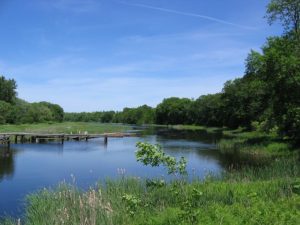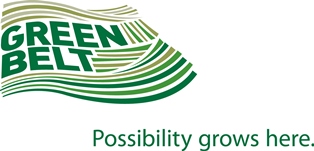Protecting Water Resources by Growing the Greenbelt
The Greater Golden Horseshoe is one of North America’s most dynamic and fast- growing regions. It is home to a vibrant economy and contains world-renowned natural features and some of Canada’s most productive farmland. Currently home to more than nine million people, the population of the Greater Golden Horseshoe is forecasted to grow to about 13.5 million by 2041.
The region’s growth and urban development is a potential threat to some water resources. Urbanization and human activities are impacting the region’s rivers, wetlands and underground reservoirs (called aquifers), and can impact both the
quality and quantity of water available to local communities, industry, and plants and animals.
Water resource areas
Ontario is taking steps to protect and preserve critical water resources by launching a public consultation on moraines, coldwater streams and wetlands under pressure from urban development in the Greater Golden Horseshoe area, but outside of the current Greenbelt.
The consultation seeks feedback on a study area for potential Greenbelt expansion in the outer ring of the Greater Golden Horseshoe.
The study area includes the following seven areas:
-
- The Waterloo and Paris/Galt moraine complex in Waterloo Region, Brant and Wellington counties.
- The Orangeville Moraine in Wellington and Dufferin counties. The moraine is located southwest of Orangeville and east of Fergus.
- Several small moraines, including the Gibraltar and Singhampton moraines, along the brow of the Niagara Escarpment in Dufferin and Simcoe counties.
- The Oro Moraine in northeast Simcoe County, west of Orillia and Lake Couchiching, which has a high concentration of wetlands and coldwater streams.
- The Nottawasaga River corridor in Dufferin and Simcoe counties. The corridor also includes the Minesing Wetland and other significant wetlands along the Nottawasaga River.
- The coldwater streams and wetlands west of Minesing in Dufferin and Simcoe counties. This location also includes catchment areas that connect the Minesing Wetland to the Niagara Escarpment.
- The coldwater steams, wetlands, and sand and gravel areas in southeast Simcoe County.
Take a look at this PDF map to compare the province’s Study Area with the proposed mapping of the Ontario Greenbelt Alliance.
We are happy to see some of our recommendations included, but there are still many missing pieces.
Growing the Greenbelt 101
The Growth Plan for the Greater Golden Horseshoe (GGH), the Greenbelt Plan, the Oak Ridges Moraine Conservation Plan and the Niagara Escarpment Plan are four provincial land use plans that work together to manage growth, build complete communities, curb sprawl and protect the natural environment. These plans support agriculture and promote economic development in Ontario’s Greater Golden Horseshoe.
 The current Co-ordinated Land Use Planning Review (Review of the Greenbelt and its proposed expansion areas) represents a unique opportunity to permanently protect Wellington County’s important moraine headwater areas including the Orangeville and Galt-Paris moraines, which supply clean drinking water directly to 171, 889 people.
The current Co-ordinated Land Use Planning Review (Review of the Greenbelt and its proposed expansion areas) represents a unique opportunity to permanently protect Wellington County’s important moraine headwater areas including the Orangeville and Galt-Paris moraines, which supply clean drinking water directly to 171, 889 people.
Wellington Water Watchers, along with over 100 other organizations support growing the Greenbelt to include significant and sensitive hydrological and ecological areas that provide benefits to millions of GGH residents. Members of the public overwhelmingly agree: more than 9 in 10 Ontarians support Greenbelt expansion to protect water supplies and natural areas, and residents and stakeholders submitted more than 45,000 petitions and letters of support during the recent Coordinated Land Use Planning Review.
We are currently in the final months of the Coordinated Land Use Planning Review and have some last opportunities to influence how much of Wellington County we can get included in the expanded Greenbelt.
Case for Urgent Action
- Climate change will compound existing population and growth pressures
- Threats to water are growing
- Data and mapping are outdated and inadequate for evidence-based decision-making
- Municipalities are largely dependent on groundwater for municipal drinking water supplies
- There is an over-supply of land necessary to accommodate population growth
We recommend growing the Greenbelt to protect a “Bluebelt” of sensitive and significant hydrological and ecological areas where urbanization should not occur, as per the new Greenbelt Plan policies 5.6.1.1 and 5.6.1.2 (see map showing proposed expansion areas at the bottom of the page)
“With 8 in 10 residents in the Grand River watershed dependent on wells for their drinking water, and an estimated 500,000 people moving to the area by 2041, the need to protect groundwater is clear. A trio of moraines – massive hills of sand and gravel left behind after the last ice age – filter and recharge most of the region’s groundwater on less than one third of its land area. They cut across at least 19 municipalities and three conservation authorities, creating a complex patchwork of local policies and regulations. Local groups and elected officials are now calling for stronger provincial protection to ensure that growth pressures, drought and climate change do not endanger water supplies in the future.” – Growing the Green, Protecting the Blue
 As citizens of the upper portion of the Grand River watershed, we have a responsibility to protect source water here for future generations within Wellington County but also for those downstream.
As citizens of the upper portion of the Grand River watershed, we have a responsibility to protect source water here for future generations within Wellington County but also for those downstream.
The Wellington County Official Plan already does well to describe protections for the Paris-Galt moraine, but does not do so for the Orangeville moraine. Greenbelt designation can provide the protection needed for these significant groundwater recharge features.
The approximately 2700 acres for Greenbelt expansion, identified by Wellington Water Watchers, lie outside land already designated for urban development needed to accommodate population growth until 2041 and beyond.
The Greenbelt and Oak Ridges Moraine Plans have been successful at maintaining watershed conditions, including forest condition and surface/groundwater quality. The landscape connections through Wellington County, including our River Corridors, Orangeville Moraine and Galt-Paris Moraine will provide for a more comprehensive and regional protection of potable water resources, working lands and natural heritage systems.





IMPORTANT ANNOUNCEMENT FROM THE MINISTRY OF MUNICIPAL AFFAIRS
December 7, 2017
The Ministry of Municipal Affairs is undertaking a consultation on a study area for potential Greenbelt expansion to protect important water resources in the outer ring of the Greater Golden Horseshoe. The study area is based on the locations with high concentrations of water resources that are under pressure from urban development.
The purpose of this consultation is to seek input on:
- The province’s approach to identifying moraines, coldwater streams and wetlands as important features for protecting water in the outer ring
- The process followed for mapping a study area based on the locations of these features
- Other factors to be considered when mapping a proposed Greenbelt boundary.
As part of the consultation, the province would also like to invite you to attend a public open house. The province will be holding the public open houses in several locations across the study area to get input from the public, municipalities, conservation authorities, Indigenous communities and organizations, and stakeholders.
For more information about the consultation, please visit Ontario.ca/greenbelt where you will find:
- A consultation document which describes this proposal in more detail and includes discussion questions related to each of these topics
- Maps of the study area
- Information about the upcoming public open houses.
We will accept input and feedback about the study area and the parameters for potential Greenbelt expansion until March 7, 2018. Input received through this consultation will help inform decisions on how to move from a study area to a proposed Greenbelt boundary.
If you have any questions about the consultation or the upcoming public open houses, please contact us by sending an email to [email protected] or calling 1-877-711-8208.
We hope you will take the time to review the consultation document and share your opinions and insights with us.
Sincerely,
Bill Mauro
Minister
Stay tuned for our analysis of this proposed study area and for further information about how we can ensure source water protection areas within Wellington County are included in the expanded Greenbelt. Click here to read our Press Release in response to today’s announcement.

Protect our Moraines!
All our work to keep our water in our watershed would be for naught if we pave over our moraines – those wonderful geologic features that do all the work for us to ensure we have pristine groundwater. The same is true for our significant wetlands and river corridors. We need to protect these important ecological treasures from the impacts of sprawl.
During the month of May, we anticipate a final proposal from the Province about what lands are to be included in the expanded Greenbelt areas. Wellington Water Watchers together with 100 other organizations formed a coalition called the Ontario Greenbelt Alliance and have mapped out the areas we believe should be included in an expanded Greenbelt, to protect farmland and essential source water protection features. See the map at the bottom of this page for the areas specific to this county.
For more information about the role of wetlands and their significance, please look at the report, “When the Big Storms Hit: The Role of Wetlands to Limit Urban and Rural Flood Damage.” This report assesses the potential for wetlands to affect the financial impacts associated with rural and urban flooding. Working with the Grand River Conservation Authority (Ontario), Credit Valley Conservation (Ontario) and Ducks Unlimited Canada, the Intact Centre on Climate adaptation (Intact Centre) determined that wetlands, if maintained in their natural state, can substantially reduce flood damage costs to buildings (ranging from residential homes and apartment buildings, to industrial, commercial and institutional structures). Click here to read more
Once the Province announces its proposals, there will be several months of an open comment period. This is our last opportunity to include vital source water protection features within Wellington County in the expanded Greenbelt.
Resources
- The Real Facts on Affordable Housing & the Greenbelt (PDF)
- Greenbelt Primer – key facts & speaking points (PDF)
- Greenbelt & Smart Growth Pledge (PDF)
- Growing Ontario’s Greenbelt – Municipal Context & Benefits (PDF)
- Quick Facts about Growing the Greenbelt (PDF)
- PDF map with overlay comparison of province’s study area & proposed mapping from the Ontario Greenbelt Alliance
- Notes from Growing the Greenbelt – Ontario Greenbelt Alliance Meeting (February 1 2018)
- Consultation documents
- Social Media Shareables
- Maps
- An Inspired Conversation Follow-Up (February 18th, 2017) brought together regional decision-makers, stakeholders and rights holders to discuss an expanded Greenbelt in Wellington County. An Inspired Conversation Follow-Up Report (10.1 MB) & Brief Report (2.6 MB)
- When the Big Storms Hit: The Role of Wetlands to Limit Urban and Rural Flood Damage
- Growth Plan implementation – Opportunities to protect nature, water and support agricultural viability
- Growing the Greenbelt – What have we done, what do we still need to do?
- OGA All member meeting: Greenbelt and growth plan changes
- Implementing the Growth Plan for the Greater Golden Horseshoe 2.0: Lessons Learned So Far to Inform Future Success?
- http://www.growourgreenbelt.ca/
- Growing the Greenbelt Q & A
- Foundation investments for Bluebelt partners
- Growing the Green, Protecting the Blue, a recent primer completed by the Friends of the Greenbelt Foundation
- The province’s Coordinated Land Use Planning Review (including the proposed ammendments to the Greenbelt)
- Planning for Health, Prosperity and Growth in the Greater Golden Horseshoe: 2015-2041
- Executive Summary from the Ministry of Municipal Affairs and Housing
Media
- Environmental Defence – Who’s playing politics with the Greenbelt? – April 30 2018
- WWW Press Release – Growing the Greenbelt in the Grand River Watershed event – February 7 2018
- Guelph Today – Greenbelt open house set for tonight – February 7 2018
- 570 News – Local group wants the province to expand greenbelt coverage – February 1 2018
- Article in Elmira Observer – Province eyes expansion of Greenbelt into the townships – December 21 2017
- News Release – Ontario Consulting on Greenbelt Expansion – December 7 2017
-
Press Release – Province’s plan to expand Greenbelt protection to vulnerable water systems applauded but bigger area needed
– December 7 2017 - Press Release | Sustainable Brant Growing the Greenbelt – December 7 2017
- Press Release – Wellington Water Watchers calls for Source Water Protection Features within Wellington County to be included in an expanded Greenbelt – December 7 2017
- Press Release – Smart Growth Waterloo Region Encourages Local Citizens to Speak Up in Upcoming Consultations – December 7 2017
- Celebrating 15 Years of Oak Ridges Moraine – April 21 2017
- Celebrate Earth Day 2017 in Ontario’s Greenbelt with this Toronto Star feature
- Statement from Friends of the Greenbelt Foundation CEO Burkhard Mausberg Regarding Provincial Announcement on the Land Use Planning Review
- Media Release, WWW – Wellington Water Watchers host a Town Hall to Support Growing the Greenbelt in Wellington County
- Media Release, WWW – Wellington Water Watchers calls decision-makers, stakeholders and rights holders to An Inspired Conversation – on growing the Greenbelt in Wellington County
- Media Release, WWW – Wellington Water Watchers calls on province to grow the greenbelt, protect water supplies
- Article: Environmental groups hope to nearly double size of the Greenbelt – Toronto Star
- Media Release – Ontario Nature: Groups call on province to grow the greenbelt, protect water supplies
Do you like this page?


